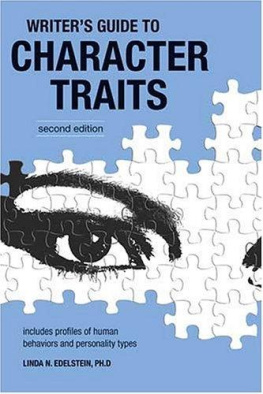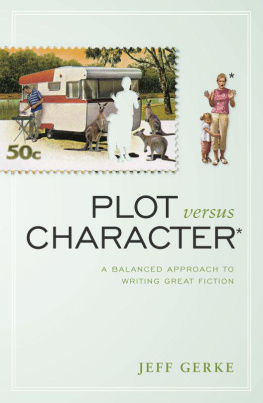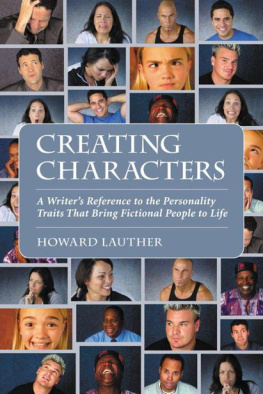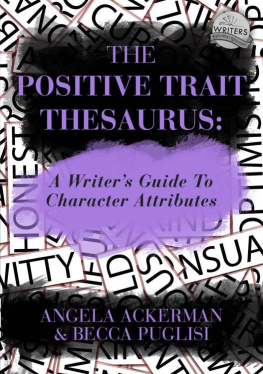TABLE OF
contents
INTRODUCTION..............................................................1
CHAPTER ONE
REAL PEOPLE AND BELIEVABLE CHARACTERS...............10
Cohesiveness and Consistency Roles Influence Traits; Traits Influence Roles Situations Influence Traits; Traits Influence Situations Relationships Influence Traits; Traits Influence Relationships Empathy Believable Characters Character History Diversity
CHAPTER TWO
ADULT PERSONALITY TYPES.........................................18
Traits of 23 Adult Personality Types With Internal and Interpersonal Attributes of Each Personality Type
CHAPTER THREE
CHILD AND ADOLESCENT TYPES...................................49
Traits of Infancy and Early Childhood Traits of Middle Childhood Traits of Adolescence
CHAPTER FOUR
PSYCHOLOGICAL DISORDERS........................................80
Early Influences Shape Personality Mild Childhood Problems Moderate and Severe Childhood Problems Adolescent Problems Problems in Adult Development Severe Disorders of Adulthood
CHAPTER FIVE
CRIMINAL TYPES.......................................................119
Types of People who Commit Nondeadly, Nonsexual Criminal Acts Types of Rapists and Others who Commit Sexual Crimes Types of Murderers Organized Crime
CHAPTER SIX
SEXUAL ISSUES.........................................................160
Traits of Sexual Behaviors Varieties of Sexual Identification Genetic Sexual Disorders
CHAPTER SEVEN
LOVE, MARRIAGE, AND OTHER ARRANGEMENTS...........173
Falling in Love Choosing a Partner Forming Relationships Marriage
Problems in Love and Marriage Separation and Divorce
CHAPTER EIGHT
CREATING A FAMILY...................................................206
Parenting Adoption Birth Order Families with a Disabled Child
Grown Children's Relationships With Parents Remarriage and Stepfamilies
CHAPTER NINE
ORDINARY AND EXTRAORDINARY EVENTS...................222
Creating Friendships Adolescence Transitions Aging Bereavement and Trauma
CHAPTER TEN
PHYSICAL AND MIND/BODY DISORDERS......................248
Remembering and Forgetting Pseudophysical Disorders Sleep Problems Substance Abuse Eating Disorders Communication Disorders Sexual Disorders
CHAPTER ELEVEN
CAREER TRAITS.........................................................279
Career Choice Career Problems Stages of Career Development Traits of People in Forty-Two Careers
CHAPTER TWELVE
GROUP INFLUENCES...................................................303
Families Group Development Traits of Leaders in Groups Roles of Group Members Traits of Specific Groups, Gangs, and Cults
CHAPTER THIRTEEN
PHYSICAL APPEARANCES AND COMMUNICATION.........330
Appearances Body Language Verbal and Nonverbal Communication

Writers ask me all kinds of questions: "What makes a man have an affair?" "Why would a woman stalk her former lover?" "How can I learn what motivates a person's behavior?" Rarely is there one answer to questions like these. But psychological research can provide vast amounts of data that can help writers, beginners and accomplished authors alike, gather accurate information about personality and behavior in order to create believable and authentic characters. My goal in writing this book has been to create a friendly reference for just that purpose. It is a crash course in psychology for writers. I describe the inner workings and behaviors of ordinaryand not-so-ordinarypeople in lists, charts, and descriptive paragraphs. All this information is not a substitute for your imagination, but a way to inspire your mind.
In my work as a clinician and teacher, I don't deal with fictional characters; I work with people. I have been in psychology since the early 1970s, so I have had a lot of time to understand the interior lives of individuals, couples, and groups: what makes them feel happy and sad, what motivates them, and what events bring them to a screeching halt. Daily, I tiptoe my way through the many layers that exist in each of us and marvel at how impenetrable most of them remain, both to ourselves and to those around us. I am continually impressednot always positivelyby the strange ways people behave. Just when I tell myself that I have heard it all, I am humbled again by the intrigues people manage to create' Dorothy Parker was right: "People are more fun than anybody." To understand people, to write about them, and to read about them is endlessly engaging. When we unravel their psychological puzzles, we ultimately shed light on our own lives.
As a psychologist, I am the ultimate reader. I sit in an armchair and read people all day long, always moving through an unfolding story, worrying, trying to understand, making sense, cheering, unraveling mysteries, and bearing witness to the search for a happy ending. This book is a synthesis of my reading, real and imagined, over the years; I wrote it because I thought it would be fun for me and helpful for others to have easy, accurate lists of qualities that hang together in personality types. In this book you will find more than four hundred lists describing individual personality types, traits associated with stages of normal child development, types of criminals, patterns of sexual behavior, dynamics of life events, family processes, responses to traumas and disasters, group and organizational dynamics, characteristics associated with people in various careers, descriptions of abnormal behavior, and other assorted informational tidbits. The lists presented here contain traits that are not my own creation, but are usually mainstream ideas accepted in psychological theory and research. Some material is on the edge, especially when I describe disorders about which little is yet known. Footnotes point you to more articles and books if you want to go deeper into any of the material.
One of the strange features about being a psychologist is that everybody else is also a psychologist. People know a great deal about psychology; we as a society have become very well informed on human emotions and behaviors. The ever-increasing array of talk shows, reality TV, interview shows, and magazines reveals both the unending desire to know about other people's lives and the genuine sophistication of the man or woman on the street with regard to psychological matters. One-dimensional, uninteresting characters have become unacceptable to the reading public.
Writers hate stereotypes because they are usually unfair, often insulting, and always boring. But stereotypes are popular because they provide us with a language shortcut.
They jolt our memories; they give us a quick, if imprecise, way of knowing, even if entire classes of peoplefat people, depressed women, post office workersare reduced to shallow mental pictures. This book is intended to help you create deeper, more coherent identities for your characters. We all see the outside of people; we see their behavior. To construct compelling characters, we need to reach inside. We need to answer questions about our characters: Why don't people leave a building when the alarm sounds? (See page 246.) Why do people fail to keep New Years resolutions? (See page 226.) What does a childhood of poverty do to personality? (See page 50.) Why do leaders of corporations fail? (See page 316.)
Individuals are complex; mere labels, such as "depressed," are inadequate. Two people suffering from the same trauma or dealing with the same emotional disorder are very different human beings with different personalities that influence their responses. For example, one parent whose son died in a senseless car crash may go to work silently each day, emotion escaping only through sobs in the privacy of a scalding morning shower. Another parent may cry and express grief openly with friends, finding solace in companionship; a third may simply want to pretend that life will soon return to normal. All three parents are grieving; no way is right and no way is wrong. Good characters break out of stereotypes; they capture our attention; they move; they get into life. Pick and choose from the traits on the lists to develop your characters, make them plausible, and enrich the personalities you have so carefully developed, so they can go on to hatch plots and make mischief.
Next page











